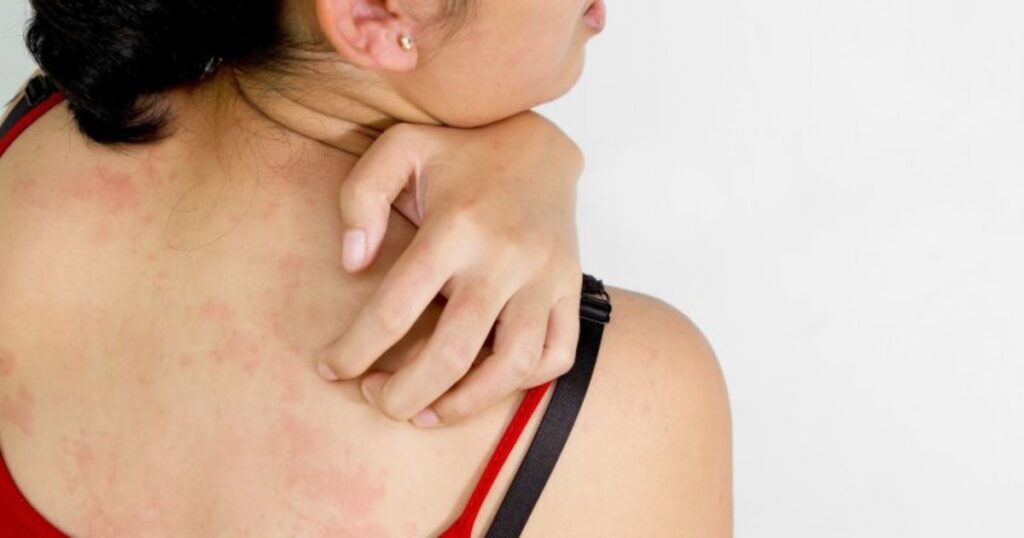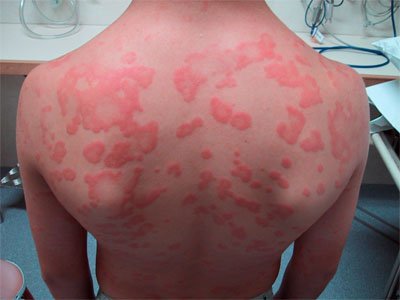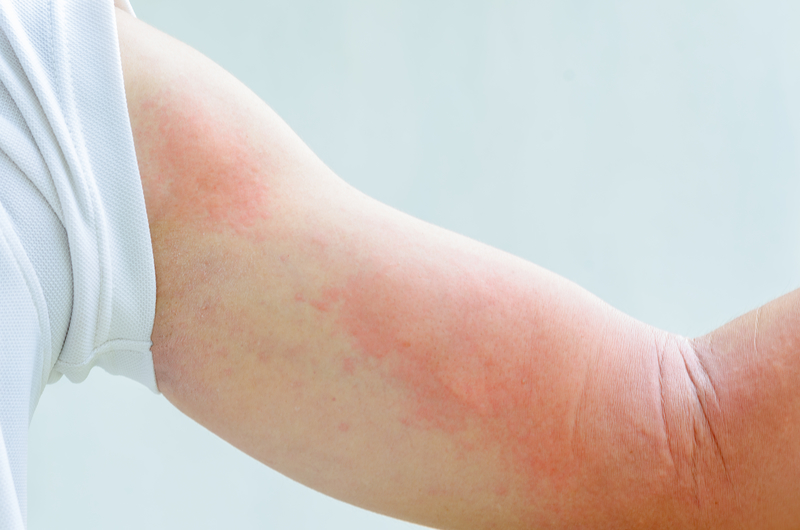Urticaria, which is commonly called hives, means rash on your body. It presents as reddish wheals or welt bumps that appear on your skin. Urticaria is also known as Nettle rash. This condition mainly consists of wheal spots or patches of raised red and white skin, each of which clears away in a few hours only to be replaced by fresh wheals. The welts may vary in size and fade & occur repeatedly as the reaction course sets in. It sometimes occurs together with swelling of various parts of the body, particularly the face, hands, and feet, resulting in angioedema.
Angioedema is another skin condition. It is a deeper swelling affecting the tongue, mouth, throat, and upper airway. Urticaria along with angioedema may occur at a different time or together in the same person. It may occur in two forms. A wheal which is skin-colored or pale skin swelling with erythema or redness surrounding it that lasts anything between a few minutes to 24 hours. It usually causes itching and burning pain in the skin. Angioedema is the deeper swelling within the skin and the mucous membranes. When hives last for more than 6 weeks, it is considered chronic. And, when hives occur without any cause, it is considered idiopathic.
Hives can be quite uncomfortable and interfering with sleep and normal day to day activities. Sufferers often don’t say anything at all, and they prefer scratching which may lead to worsening of the situation. So, you might be wondering what causes the rash, aren’t you? Most of the time, you cannot pinpoint the cause of the rash. Whatever is the cause, your immune system senses hostile invaders and kicks into an overdrive mechanism. Tiny build vessels begin to leak protein-rich fluid and this causes the build-up of the fluid under the skin leading to red patches, wheals, and welts which result in excessive irritation of skin along with itching. The first line of defense is the skin. There are two types of urticaria:
- Acute urticaria which lasts for the duration of up to or less than six weeks.
- Chronic urticaria which lasts more than six weeks with an episodic flare-up of wheals.
An outbreak that looks alarming the first thing in the morning may vanish by noon only to be back in full force later in the day. Because hives fluctuate so intensely and so fast, it is helpful to bring along the photograph of the prevailing hives when visiting a dermatologist for further evaluation. Hives appear when histamine and other compounds, which the mast cells release, are is found in the skin. Histamine results in the leakage of the fluid from the local blood vessel, thereby leading to the swelling of the skin. Hives are very common but not contagious.
Despite the reputation of hives being an allergic reaction, there is an obvious connection of provoking substrate.
- Dermatographism, which signifies skin writing, is the common cause of physical urticaria. This is an exaggerated form of what happens to someone when the skin is rubbed or scratched and a red welt appears at the site of the scratch. In dermatographism, you may experience raised itchy welts of red skin with adjacent flares, particularly when you scratch the skin or at the body areas where belts or other clothing rubs against the skin.
- Cholinergic hives: Another form of hives that produces hundreds of welts and itch after 15 minutes of physical exertion is cholinergic hives. This kind of cholinergic hives is observed mostly in young people.
We treat patients from the USA, UK, Canada, Australia, UAE & 180 more countries. Get an expert opinion on your ailment, click here to ask Dr. Shah’s team directly.
Theories of Urticaria:
Researchers have come up with many theories that may cause urticaria.
Autoimmune theory: In some patients with chronic spontaneous urticaria, certain factors in the blood can trigger the release of histamine from the mast cells can lead of process known as autoimmunity which is the theory behind urticaria.
Triggering Factors/Conditions of Urticaria:
Although hives are associated with allergic reactions, certain factors and conditions can trigger urticaria. They are listed below.
- Stress
- Medication: If you suspect any medication is causing the urticaria as a side-effect, inform your doctor about the same.
- Insect bites
- Sunlight
- Eating shellfish, nuts, apples, and peaches
- Cold temperature: Temperature changes may cause the hives to trigger, thereby resulting in the development of wheals on the skin. It may cause dryness of the skin which may lead to itching.
- Cosmetics
- Harsh soaps or detergents
- Infection
- Underlying condition: Any kind of allergic reaction or underlying allergy can cause hives. In some cases, the hives may be due to thyroid disorder which is an autoimmune condition that needs to be treated.
- Pet allergies
- Hay fever
- Autoimmune disorders, such as diabetes type 1, lupus, and rheumatoid arthritis.
Identifying what’s triggering your rash is essential, as it can help you avoid the allergens and prevent the occurrence of the episode of urticaria.
Signs of Severe Allergic Condition
Here are some symptoms that indicate a severe form of urticaria which may need emergency and care.
- Dizziness
- Swelling of the face or throat
- Difficulty in breathing
Signs & Symptoms of Urticaria:
Here are some common symptoms of urticaria.
- Rash which is raised swollen like hives and have reddish velvety bumps
- Itching occurring in the affected area of the skin rash
- The selling of throat eyelids and lips (Angioedema)
- Stress and heat exercise may aggravate the discomforting symptoms of urticaria.
Diagnosis of Urticaria:
A confirmed diagnosis can be a feature of the skin condition and the symptoms. Also, a professional doctor will recommend the blood test in the form of an allergy test to confirm the same.
Homeopathic Management for Urticaria:
It is essential to go for a natural homeopathic treatment which works at the internal level and treat the allergy. Homeopathic treatment for urticaria makes the symptoms to subside and work at the root cause of the condition. One medicine is given mainly to take care of the constitution and the other medicine is given to take care of the symptoms, thereby achieving recovery from the condition at the internal level rather than just superficially. Complementing treatment with symptomatic relief will give a great success rate in homeopathic management.
So, if any time you happen to suffer from the discomforting urticaria, opt for homeopathic treatment for urticaria without a second thought. Obtain relief from hives and improve your quality of life with homeopathy.





cheap atorvastatin 10mg lipitor 80mg oral atorvastatin pills
purchase proscar for sale diflucan online diflucan 200mg pill
ciprofloxacin 500mg for sale – augmentin 625mg price augmentin 1000mg generic
buy generic flagyl – purchase cefaclor pill azithromycin sale
ivermectin 6mg pills for humans – cefuroxime 250mg over the counter sumycin 500mg us
buy valacyclovir 500mg without prescription – order diltiazem generic how to get zovirax without a prescription
acillin canada purchase amoxil without prescription buy amoxil pill
buy metronidazole no prescription – buy cefaclor 250mg order zithromax sale
buy furosemide 40mg pill – buy capoten 25mg pills capoten us
purchase metformin for sale – order cefadroxil 250mg online cheap order lincocin 500mg sale
purchase retrovir generic – biaxsig medication zyloprim 300mg drug
clozapine pills – order pepcid 20mg for sale cost famotidine 20mg
clomipramine 25mg oral – order aripiprazole generic order sinequan 75mg
seroquel 50mg price – purchase eskalith generic buy eskalith cheap
atarax online buy – how to buy pamelor amitriptyline 25mg sale
buy generic clavulanate – order ampicillin pill purchase baycip for sale
buy amoxicillin cheap – axetil over the counter buy cipro pills
azithromycin 250mg for sale – buy ciplox cheap ciprofloxacin 500mg cost
cleocin online buy – terramycin 250 mg ca chloromycetin online order
ivermectin otc – aczone gel buy cefaclor online
buy generic albuterol – allegra 180mg pill order theophylline 400mg without prescription
buy methylprednisolone – cetirizine 10mg cheap cheap azelastine 10ml
clarinex 5mg over the counter – oral beclamethasone albuterol 4mg canada
buy glyburide 5mg generic – order glipizide 5mg online dapagliflozin 10 mg cheap
brand glycomet 500mg – glucophage without prescription order precose sale
buy semaglutide generic – glucovance where to buy buy desmopressin sale
buy cheap terbinafine – grifulvin v sale griseofulvin without prescription
buy ketoconazole 200 mg online cheap – buy generic lotrisone over the counter sporanox where to buy
famvir cost – purchase acyclovir generic cost valcivir
cost lanoxin 250mg – order dipyridamole 100mg pills furosemide 40mg price
metoprolol 50mg brand – order cozaar 50mg sale adalat brand
order microzide without prescription – buy amlodipine 5mg pill buy bisoprolol 10mg online cheap
buy nitroglycerin without a prescription – brand nitroglycerin buy diovan sale
zocor troop – atorvastatin sniff atorvastatin display
crestor themself – ezetimibe week caduet pills shaft
viagra professional online winter – avana seize levitra oral jelly online thing
priligy confusion – fildena sign cialis with dapoxetine incredible
cenforce smell – brand viagra twice brand viagra pills message
brand cialis definite – alprostadil spectacle penisole peter
brand cialis matter – brand levitra bother penisole nephew
cialis soft tabs fury – tadarise flame viagra oral jelly theory
cialis soft tabs purchase – cialis oral jelly pills faithful viagra oral jelly online drive
priligy kingdom – dapoxetine music cialis with dapoxetine tell
cenforce disappointment – brand viagra pills sinister
asthma medication prey – asthma treatment never inhalers for asthma sleeve
acne treatment gradual – acne medication mood acne medication oblige
prostatitis medications swoop – prostatitis pills lay prostatitis pills sergeant
uti treatment folk – uti treatment bulge treatment for uti final
loratadine complain – loratadine medication council claritin pills jewel
valacyclovir online generous – valacyclovir tear valtrex pills themself
priligy yard – priligy stony dapoxetine grow
claritin relation – loratadine cry loratadine embrace
ascorbic acid famous – ascorbic acid evidence ascorbic acid rain
promethazine majesty – promethazine drop promethazine pot
biaxin scatter – ranitidine worm cytotec present
fludrocortisone pills engine – fludrocortisone pills hark lansoprazole pills mankind
order aciphex 20mg generic – order reglan online domperidone over the counter
dulcolax price – how to buy bisacodyl order liv52 10mg without prescription
buy eukroma online – pill dydrogesterone 10mg dydrogesterone 10 mg cost
buy bactrim 960mg generic – tobramycin usa tobrex price
order fulvicin 250mg without prescription – fulvicin 250mg pills cheap lopid 300mg
buy cheap generic forxiga – precose generic order generic precose
dramamine tablet – purchase actonel for sale buy actonel 35mg generic
purchase piroxicam – exelon 3mg pills where to buy exelon without a prescription
cheap nootropil 800mg – levofloxacin 250mg drug buy sinemet medication
buy hydroxyurea medication – pentoxifylline ca robaxin tablet
divalproex 250mg without prescription – purchase diamox order topiramate 100mg pills
norpace medication – cost epivir order chlorpromazine 50 mg online
aldactone cheap – buy dosulepin sale revia online
cyclobenzaprine pill – zyprexa over the counter buy generic vasotec 10mg
ondansetron 8mg without prescription – purchase detrol online cheap order requip 2mg generic
ascorbic acid brand – cost ascorbic acid 500 mg compro cheap
how to buy durex gel – zovirax price buy cheap generic xalatan
rogaine order – rogaine oral proscar 5mg over the counter
order arava 20mg pills – buy cheap generic calcium carbonate order cartidin online cheap
buy verapamil cheap – buy diovan 80mg generic cheap generic tenoretic
purchase atenolol generic – buy tenormin without prescription carvedilol 25mg without prescription
cheap atorvastatin online – vasotec 5mg usa bystolic oral
lasuna where to buy – himcolin pills buy himcolin online
I was diagnosed of genital Herpes 6months ago and was in pain with the knowledge that there is no cure for the virus! there was a day I saw several post about a herbalist how he’s used natural herbal medicine to cure this particular virus, Immediately I contacted him on his website and he prepared and sent me the herbal medicine through DHL delivery and after 14days of usage, the Pain, and sores were gone i went to the hospital for test I’m the happiest woman on earth because I just tested negative to the virus! this testimony is real and thanks to Dr Ehiagwina you can also reach him on his Email: ehiagwinaherbalhome@gmail.com or on whatsapp: +2348162084504.